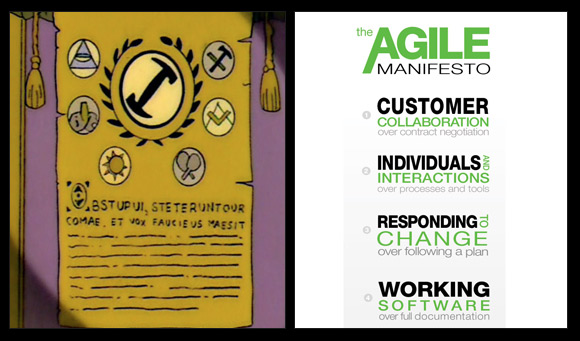 |
| Let's do whatever we want and call it a new flavor of Agile! |
So how can you tell if you're Agile? I recommend asking three groups of people: your peers, your clients, and yourselves.
Your Peers
If you're an Agile team operating as part of a larger organization, there should be a balance between competition and collaboration between teams. Everyone wants their team to be the best, but not because the other teams are so bad. You should be working hard to improve your competition, a.k.a. the other teams in the company, so that they, in turn, will push you to be better.
Ask your peers how Agile you are and be prepared for some candid yet constructive feedback. Remember, you're all in this together. Cross-pollination and frequent feedback from your peers makes everyone better.
Your Clients
It doesn't matter what the nature of your team is, your code is being used by someone. Whether it's an end-customer, a business user in another division, another system within your technical organization, etc., there's somebody who uses what it is you're building. The Agile Manifesto and its Principles make it very clear what kind of relationship with and service to our customers we should be striving for. All you have to do is ask your clients whether they feel that relationship and service is there.
You should also look for ways to continuously improve how your interact with and serve your clients. What delights your customers today will soon become the status quo. If you're a good Agile team, you're meeting with your customers and getting feedback on a frequent basis, anyway. Take some time to go over how you're delivering, not just what you're delivering.
Yourselves
We are often our harshest critics. I encourage all Agile teams to have everyone on the team fill out some sort of self-assessment on a regular basis (a quick search will provide you some examples). By getting as many responses as possible, you avoid the extreme ups and downs that come from individuals. Look at the mean and median results, then discuss your perceived strengths and weaknesses as a team.
Sometimes we feel we're at the top of our class because we're excelling at what we understand Agile to be. It's important to stay involved with the greater Agile community so you can find out the latest and (potentially) greatest practices and techniques for driving Agility. Even more importantly, recognize that there's no such thing as perfection, only better, and instill a passion for continuous improvement within your team.
And Also...
I'm sure there are other ways to gauge a team's Agility. What other ways would you recommend for teams to assess how Agile they are? Is there a place for "Extreme" or "Hyper" Agile in our vernacular? Is it a positive thing to have pockets of disproportionately high Agile maturity in your organization? What are you doing to drive an overall increasing Agile maturity?


